Lupinus adsurgens is a species of lupine known by the common name Drew's silky lupine. It is native to the Sierra Nevada and coastal mountain ranges of northern California and southern Oregon, where it grows in forest and other mountain habitat. It is a perennial herb growing 20–60 centimetres (7.9–23.6 in) in height. Each palmate leaf is made up of 6 to 9 leaflets each up to 5 centimetres (2.0 in) long. The herbage is hairy and silvery or gray-green in color. The inflorescence is up to 23 centimetres (9.1 in) long, bearing flowers just over a centimeter long. The flower is pale pink or purple to yellowish with a white or yellow patch on the banner. The fruit is a silky-haired legume pod 2 to 4 centimetres (1.6 in) long containing 3 to 6 seeds.
Lupinus andersonii is a species of lupine known by the common name Anderson's lupine.

Lupinus angustiflorus is a species of lupine known by the common name narrowflower lupine. It is endemic to California, where it grows in the volcanic soils of the northeastern mountains and Modoc Plateau. It is an erect perennial herb sometimes exceeding one meter in height. Each palmate leaf is made up of 6 to 9 leaflets each up to 6 centimeters long. The inflorescence is up to 34 centimeters long, bearing many flowers each of which is roughly a centimeter long. The flower is cream to pale yellow-orange with a patch of deeper yellow or orange on its banner. The keeled lower petals may be tipped with lavender. The fruit is a hairy legume pod up to 4 centimeters long.
Lupinus antoninus is a rare species of lupine known by the common name Anthony Peak lupine. It is endemic to northern California, where it is known from only four occurrences in the North Coast Ranges, including near Anthony Peak.

Lupinus brevicaulis is a species of lupine known by the common names shortstem lupine and sand lupine. It is native to the southwestern United States and Great Basin area and into northern Mexico, where it grows in many types of sandy habitat. This is a hairy annual herb growing nearly flat in a spread on the ground with a stem just a few centimeters long. An array of leaves encircles the base. Each palmate leaf is made up of 6 to 8 leaflets about a centimeter long and a few millimeters in width. The inflorescence is a petite spiral of flowers a few centimeters long just arising past the basal disc of leaves. Each flower is 6 to 8 millimeters long and bright blue in color, generally with a white or yellowish spot on its banner. The fruit is a hairy legume pod about a centimeter long containing 1 or 2 beanlike seeds.
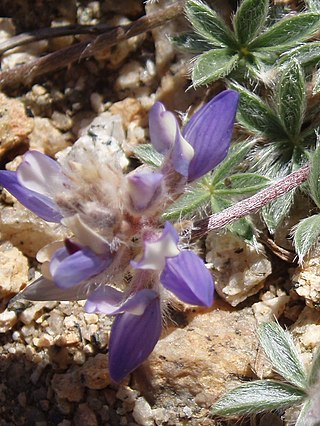
Lupinus breweri is a species of lupine known by the common names Brewer's lupine and matted lupine. It is native to much of California, except for the deserts, and to adjacent sections of Oregon and Nevada, where it is common in some areas, particularly mountain forests. Quite short for a lupine, this is a hairy, mat-forming perennial herb, sometimes becoming like a shrub, with a woody base. The leaves spread out from the stem. Each palmate leaf is made up of 5 to 10 woolly leaflets each up to 2 centimeters (0.79 in) long. The inflorescence is a dense raceme of flowers a few centimeters tall, each flower 4 to 11 millimeters. The flower is blue or purple with a white or yellowish spot on the banner. The fruit is a silky-hairy legume pod 1 or 2 millimeters long.
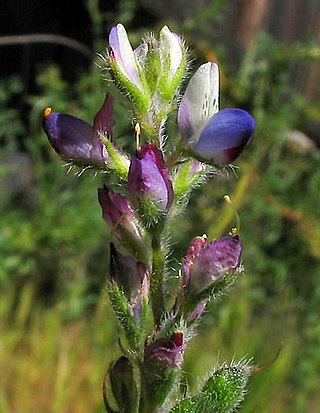
Lupinus concinnus is a species of lupine known by the common name Bajada lupine. It is native to the southwestern United States from California to Texas, and northern Mexico, where it is known from many types of habitat. This is a hairy erect or decumbent annual herb with a stem growing 10 to 30 centimeters long. Each small palmate leaf is made up of 5 to 9 leaflets up to 3 centimeters long and under a centimeter wide, sometimes narrow and linear in shape. The inflorescence is a dense spiral of flowers, with some flowers also appearing in leaf axils lower on the plant. Each flower is 5 to 12 millimeters long and purple, pink, or nearly white in color. The fruit is a hairy legume pod around a centimeter long.
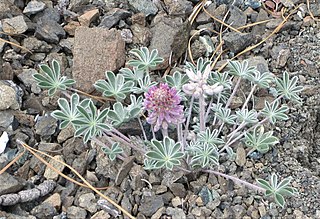
Lupinus constancei is a species of lupine known by the common name The Lassics lupine, or lassicus lupine. It is endemic to California, where it is known from only two occurrences in the Lassic Range in the North Coast Ranges. It is a member of the serpentine soils flora of the mountain forests. This is a low, mat-forming perennial herb no more than 15 centimeters high. Each small palmate leaf is made up of 6 or 7 leaflets up to 2 centimeters long and one wide. The herbage is coated in long, shaggy hairs. The inflorescence is a small, dense clump of several centimeter-long flowers. Each flower is pink in color with darker pink at the tip of the keel. The yellowish banner is reflexed. The fruit is a hairy legume pod 1.5 to 2.5 centimeters long.

Lupinus croceus is a species of lupine known by the common name saffron-flowered lupine. It is endemic to the northernmost mountains of California, including the Klamath Mountains, where it grows in generally dry, rocky habitat. This is an erect perennial herb growing 40–60 centimetres (16–24 in) tall. The hairy palmate leaves are made up of 5 to 9 leaflets each up to 6 centimetres (2.4 in) long. The inflorescence is a raceme of many flowers, sometimes arranged in whorls. Each flower is just over a centimeter long and bright yellow to orange in color. The fruit is a hairy legume pod up to 3.5 centimetres (1.4 in) long.
Lupinus elatus is a species of lupine known by the common name tall silky lupine. It is endemic to California, where it is known from the Transverse Ranges above Los Angeles, and possibly also from the southernmost slopes of the Sierra Nevada. Its habitat includes dry areas in the forests of the mountains. This is an erect perennial herb reaching a maximum height near 90 centimeters. Each palmate leaf is made up of 6 to 8 leaflets up to 8 centimeters long. The herbage is coated in silvery silky to woolly hairs. The inflorescence is a long raceme of flowers, each about a centimeter long and arranged in whorls. The flower is purple or blue with a pale yellow patch on its banner. It yields a legume pod 2 or 3 centimeters long. This is a host plant to the Southern California native butterfly subspecies known as the San Gabriel Mountains Arrowhead Blue.
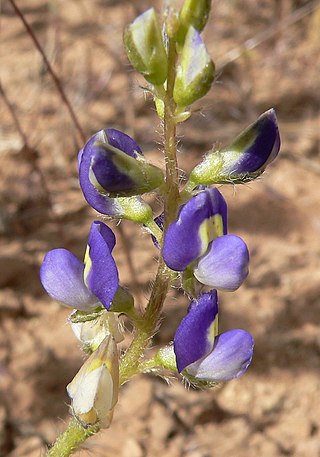
Lupinus flavoculatus is a species of lupine known by the common name yelloweyes, or yellow-eyed lupine.
Lupinus grayi is a species of lupine known by the common name Sierra lupine. It is endemic to California, where its distribution extends the length of the Sierra Nevada and its foothills and includes the Tehachapi Mountains.

Lupinus luteolus is a species of lupine known by the common names pale yellow lupine and butter lupine. It is native to the coastal mountain ranges of Oregon and California as far south as the Transverse Ranges, where it grows in open habitat such as clearings and sometimes disturbed areas. It is an annual herb with a rigid stem growing to maximum heights anywhere between 30 centimeters and 1.5 meters, and known to exceed that at times. Each palmate leaf is made up of 7 to 9 hairy leaflets 1 to 3 centimeters long. The inflorescence is a raceme of crowded whorls of flowers each just over a centimeter long. The flower is often pale to bright yellow, but can be blue or pinkish. The fruit is a hairy, rounded or oval legume pod generally containing 2 seeds.
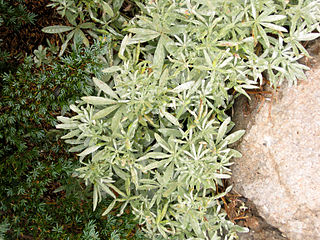
Lupinus obtusilobus is a species of lupine known by the common name bluntlobe lupine. It is native to high mountains of northern California, including the North Coast Ranges, the Klamath Mountains, and the northernmost Sierra Nevada. It grows in various types of mountain habitat, sometimes carpeting meadows with its purple blooms in the spring. It is a perennial herb growing erect or decumbent along the ground, its stem 15–30 centimetres (5.9–11.8 in) long. Each palmate leaf is made up of 6 to 7 leaflets up to 5 centimetres (2.0 in) long. The herbage is coated in silvery silky hairs. The inflorescence is a small raceme with a few whorls of flowers each just over a centimeter long. The flower is blue to purple with a yellowish patch on its banner. The fruit is a silky-haired legume pod up to 4 centimetres (1.6 in) long.

Lupinus padre-crowleyi is a rare species of lupine known by the common names Father Crowley's lupine and DeDecker's lupine. It is endemic to California, where it is known only from the eastern slopes of the Sierra Nevada and the high plateau below along the western border of Inyo County. It grows in the granite soils of the mountain forests and scrub. It has been noted at fewer than 20 locations. This is a perennial herb growing an erect inflorescence from a mat of silvery, woolly-haired herbage, reaching maximum heights over half a meter. Each palmate leaf is made up of 6 to 9 leaflets up to 7.5 centimeters long. The inflorescence is a raceme of whorled flowers each just over a centimeter long. The flower is cream to pale brownish yellow in color. The fruit is a silky-haired legume pod containing black-mottled white seeds.
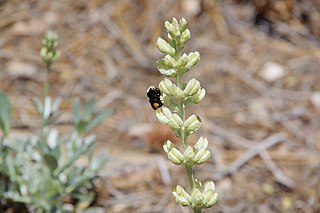
Lupinus peirsonii is a rare species of lupine known by the common names Peirson's lupine and long lupine. It is endemic to the San Gabriel Mountains of Los Angeles County, California, where it grows in woodland and forest habitat. It is an erect, branching perennial herb growing 30 to 60 centimeters tall. Each palmate leaf is made up of 5 to 8 fleshy leaflets up to 7 centimeters long. The herbage is coated in silvery silky hairs. The inflorescence is a raceme of whorled yellow flowers each about a centimeter in length. The fruit is a silky-haired legume pod 3 or 4 centimeters long.

Lupinus sericatus is a species of lupine known by the common name Cobb Mountain lupine. It is endemic to the North Coast Ranges of California north of the San Francisco Bay Area, where it grows in the forest, woodlands, and chaparral of the slopes and canyons. It easily colonizes disturbed habitat as well. This is a perennial herb growing up to half a meter tall. Each palmate leaf is made up of 4 to 7 distinctive wide spoon-shaped leaflets each 3 to 5 centimeters long. The inflorescence is a raceme of several whorls of purple flowers, each flower between 1 and 2 centimeters long. The fruit is a hairy legume pod 2 or 3 centimeters long.

Lupinus stiversii is a species of lupine known by the common names harlequin annual lupine and harlequin lupine. The plant was named for Army physician Dr. Charles Austin Stivers, who first collected it in 1862 near Yosemite.
Lupinus tracyi is a species of lupine known by the common name Tracy's lupine. It is endemic to the Klamath Mountains of southern Oregon and northern California, where it grows in coniferous forests. It is a perennial herb growing 20 to 70 centimeters tall and is mostly hairless in texture, with a thin, waxy stem. Each palmate leaf is made up of 6 or 7 leaflets measuring 1 to 4 centimeters in length. The inflorescence is a raceme of many flowers, sometimes arranged in whorls. The flower is around a centimeter long and is pale blue to whitish in color. The fruit is a hairy legume pod roughly 2 centimeters long which darkens as it dries.

Lupinus truncatus is a species of lupine known by the common name collared annual lupine.













